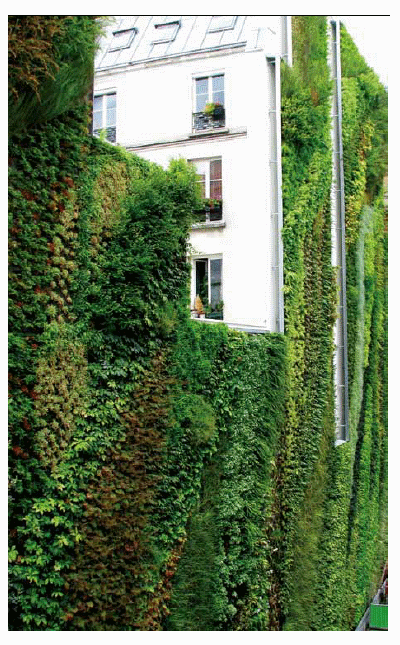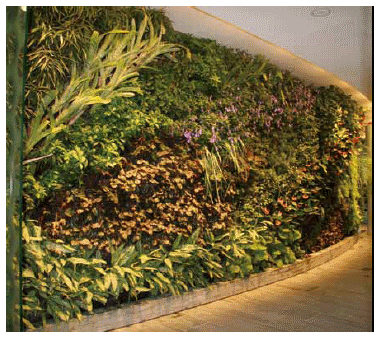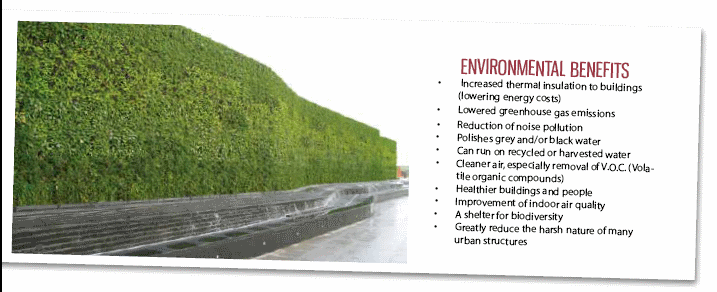Off the Wall – Living walls
Featured article from September / October Alfresco Magazine 2009
Landscape designer Sandra Batley investigates the concept of Living Walls, the latest gravity defying technology literally changing the way we view gardens.
Hydroponic Panel System: Usually comprising pre-planted panels that are bought on site and connected to a customized rail and bracket system that is then attached to the wall. It has a mechanical irrigation and fertiliser system, usually with a gutter drain at the bottom. Developed as a modular basket system used like cladding to create a ready-made green space. This system is soil free. Soil based Panel System: This is also a modular system using 500x500mm panels made from rigid 80% post industrial polyethylene (the most environmental plastic) panel and is fully recyclable. It has a planting depth of 62mm but this can be doubled by using a clever extension kit. They are simply attached to the wall by a recycled plastic mounting strip that spreads the weight across the panel and two screws secure it in place. Irrigation drip-lines are usually installed to control watering requirements. It can also be watered using a simple wand for the garden or via a trough with holes at the top of the panel and one at the bottom to collect any run off.Felt System: a hydroponic technique where plants are fitted as seeds, cuttings or already grown plants into a layer of felt made of polyamide. The felt is rot proof and its high capillarity allows good water distribution. This is then mounted on a 10mm thick PVC layer as a waterproof membrane which is riveted to a lightweight metal framework. The felt is kept continually moist with water that is supplemented with nutrients. Watering and fertilising is also automated. The whole weight of the panel, including plants and metal frame is lower than 30kg per panel. Therefore it can be installed on any wall with any size or height requirements. Interior Living Walls: Walls can be built out of any of the above three systems and set up indoors. Artificial lighting is then usually required. Plants grown indoors cleanse and humidify the air, thus improving the working conditions. Living walls create a ‘green space’ vertically, it allows man to re-create a living system very similar to natural environments. Current research has shown there are a number of positive benefits environmentally and commercially as well as for their sheer aesthetic beauty
Living walls are either hydroponic or soil based systems where water and nutrients are fed to the wall via an automated irrigation system. Some walls are designed to use recycled grey and black water such as the walls in Melbourne City Council’s CH2 building. The usual requirements of pruning, feeding and watering still apply when maintaining living walls.
As with any planting design, the orientation and microclimatic conditions of the area determines the choice of plant species and the visual effect you want to achieve. Many plants thrive in living walls such as epiphytes (plants which grow above the ground surface, using other plants or objects for support), lithophytes (plants that grow in or on rocks), bromeliads, ferns, succulents, climbers and grasses. Native as well as exotic species have been successfully used. Different colours of foliage are used to form tight knit patterns, while on other walls, large-leaved plants contrast with small-leaved species to give a lush textural contrast. The overall effect is incredibly rich, like a tapestry or a carpet. There is also interest in the possibility of growing food on living walls. There are proposals in China to create vertical greenhouses where families can grow food close to their living quarters. In any city or garden around the world a naked wall can be transformed into a vertical garden. Living walls are an emerging technology than can help improve our urban landscape, create a more pleasant, healthier workplace and offer a new way to beautify the built environment.
 Sandra Batley is principal designer for Flourish.
Sandra Batley is principal designer for Flourish.








Thanks for your article above Sandra. It was a great read. Are the panels available for purchase, if so, do you know where? Also, my 18 year old son had designed a house that is nearing comnpletion (he was 16 when he designed it!) and we have the perfect internal concrete wall and natural lighting for a living wall. He recently saw the ‘Qantas’ living wall and as an after thought, would like to add one to his design. Irrigation connection would be difficult as the walls are ‘filled’ concrete blocks. Do you know of a portable system by chance? Kind regards
We design and build complete walls to our clients brief. Retro fitting to existing walls is usually simple. Walls may need a drainage outlet, particularly if they are internal.
where do you get the polyamide felt from.